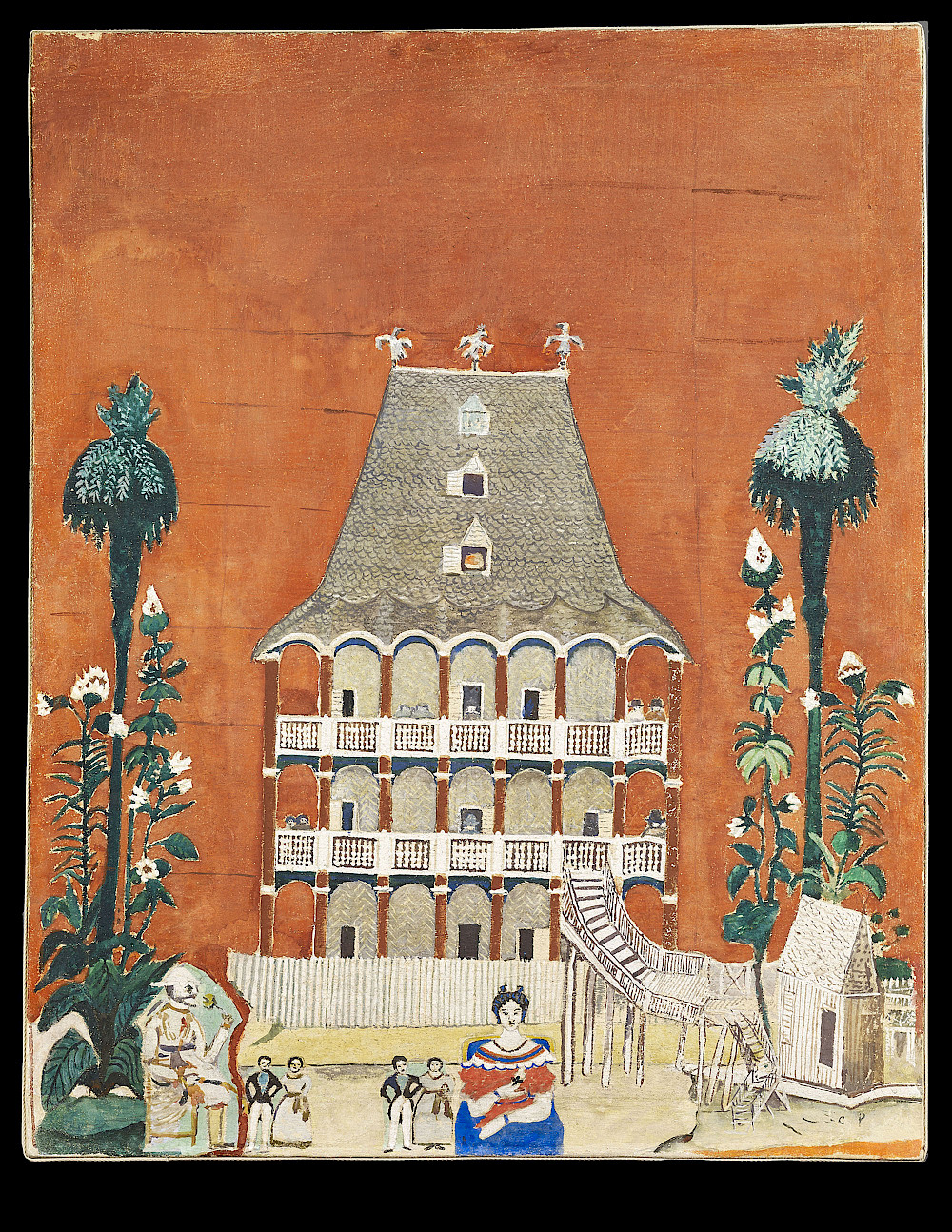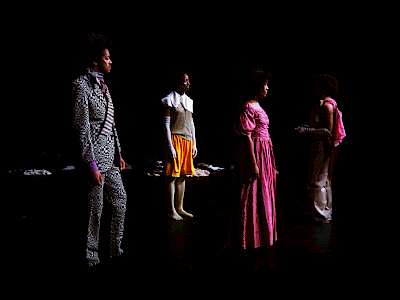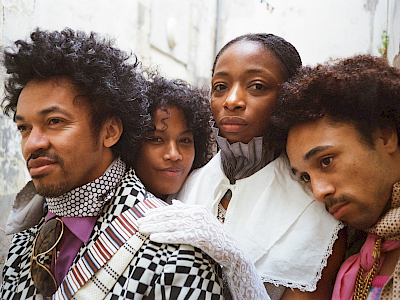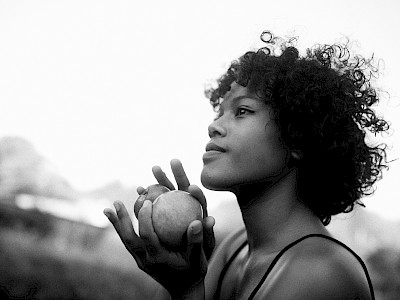25 — 29.05.2024
Soa Ratsifandrihana Brussels
Fampitaha, fampita, fampitàna
dance — premiere
| French, Malagasy, Haitian Creole → NL, FR, EN | ⧖ 1h | €20 / €16
Fampitaha, fampita, fampitàna – three Malagasy words that mean comparison, transmission and rivalry. In a score of abstract and figurative gestures, dancer and choreographer Soa Ratsifandrihana makes use of her own experience of diaspora and her Madagascan origins to tell us the kind of story she would have liked to have heard or seen as a child. Blending radio, musical and choreographic storytelling, the show plays with orality and movement, reminding us that our bodies, just like our words and sounds, are bearers of stories. Ratsifandrihana – who came to attention as a dancer in Rosas’ new version of Fase – drew inspiration from the words and stories she picked up on a recent trip to Madagascar. Joined by guitarist Joël Rabesolo and performers Audrey Merilus and Stanley Ollivier, she travels towards a form of wandering, exploring how several influences can lead to an unheard-of explosion of cultures like creolisation. Just as the change in accentuation between ‘fampitaha’, ‘fampita’ and ‘fampitàna’ alters the word’s meaning, the dancers glide from one state to another, seemingly following a constantly changing movement – or perhaps a form of creolisation.
Interview with Soa Ratsifandrihana
Fampitaha, fampita, fampitàna is your second piece. What was your first encounter with dance?
It all began in our living room where I danced a lot. Although my parents are scientists, they still listened to a great deal of music, particularly jazz and disco. That’s when I started having a real appetite for movement and singing. I was just five when I started taking physical expression classes. I went on to study biology and geology at university and my parents would have liked me to continue along that path, but it just made me even more motivated to do dance. I was able to join the conservatoire in Paris where I took a fairly academic course, and at 19 started performing for James Thierrée, Salia Sanou and Anne Teresa De Keersmaeker.
What motivates your creations?
My solo gr oo ve was a return to what’s essential, an act of discovering and sharing the pleasure of dance again with generosity. In Fampitaha, fampita, fampitàna I took this journey back to the self with two other choreographic artists and a musician who is part of the Madagascan diaspora in Brussels. It’s about sharing our ambivalence, our contradictions as children from different diasporas, but also what’s recorded in our bodies. These people have experienced similar things to me, but don’t necessarily ask the same questions or give the same answers. Audrey Mérilus is a contemporary dancer and curator, and Stanley Ollivier is a creator of performances, a DJ and a radio presenter. We’re three French choreographic artists looking to rediscover the essential pleasure of dancing, a dimension that is often brushed aside for the sake of remaining representative or neutral, so much so that in the end you no longer know what dancing means.
What place does your relationship with Madagascar have in your creation Fampitaha, fampita, fampitàna?
I’ve only spent six months of my life in Madagascar, but I’ve got family there and I feel quite close to its culture. I’m currently learning Malagasy, which I listened to when I was a child but didn’t speak. My piece Fampitaha, fampita, fampitàna is a diptych. The first part is a piece for radio about a trip I did to Madagascar, where I met a historian, a couple of storytellers, a slammer, choreographers etc. This Rouge cratère podcast, which is about orality and language, was broadcast on radio, but it’s also an integral part of the show (note: available on listening platforms from 26 June 2024). In the diptych, I question colonial history since I’ve had direct experience of social and economic asymmetries and experienced for myself the lack of tools in Europe for learning Malagasy and finding out about Madagascar’s history. The perspective in European works is more anthropological or is tinged with the colonial gaze, despite a desire for objectivity.
So are there elements in Madagascan dances that inspire your choreographic writing?
Not moves as such, but more a state of mind and energy. I like watching these dances, but have never learnt them, except for a few dances for festivities and celebrations that are held among the Madagascan diaspora. But when she watched me dance, a choreographer in Madagascar told me that she had the impression I’d never left the island. So there’s something deeper, a form of responsiveness that has resisted academic teaching. It’s something I also share with the musician Joël Rabesolo, who comes from the jazz scene but navigates with freedom and brio through a wide range of musical genres. He wrote the music for Fampitaha, fampita, fampitàna as it was being created.
While the show is about your experiences as children of the diaspora in Europe, its title is still in Malagasy. What do the three words mean?
Fampitaha means “comparison”. Translated literally, it means “I see the reflection of me through you”. It’s the idea of a mirror, but it’s also a 19th century dance that can still be found now in rural and urban areas alike despite colonisation. It involves an encounter between two teams of dancers who improvise, like today’s battles. The best dancers were invited to dance before the king or queen. That’s when lots of folk dances, which are now considered traditional, were created. Fampita means transmission. The word represents the exchanges with the people I met in Madagascar, the transmission of the language, the past, the way of expressing yourself and gestures, because there’s a great richness in that. And fampitàna is the rivalry that can exist between hegemonic cultures and cultures still referred to as ‘sub-cultures’.
You mention Édouard Glissant’s thinking as a source of inspiration. His concept of creolisation brings your blend of artistic languages to mind.
His writing has accompanied me and was advised by a close collaborator, Sékou Séméga, who poetically guided the writing of Rouge cratère and the performance. The idea of the journey and circulation features in my work. Also, in terms of questions around language, the dancers’ bodies are voiced. So they won’t stay silent. We have things to say. And that also reflects our very collaborative encounter-based work process.
Interview by Thomas Hahn
April 2024
Presentation: Kunstenfestivaldesarts, Théâtre Varia, Kaaitheater
Artistic direction: Soa Ratsifandrihana | Choreography and performance: Audrey Mérilus, Stanley Ollivier, Soa Ratsifandrihana | Footwork sentence from Raza | Music and performance: Joël Rabesolo | Dramaturgy: Lily Brieu Nguyen | Artistic collaboration: Jérémie Polin Razanaparany aka Raza, Amelia Ewu, Thi Mai Nguyen | Lighting design: Marie-Christine Soma | Costume design: Harilay Rabenjamina | Sound design: Chloé Despax, Guilhem Angot | Support questions on transmission & identity: Prisca Ratovonasy | Texts: Sékou Semega | Videos: Valérianne Poidevin | Technical management: Blaise Cagnac | Light technician: Diane Guérin | Sound technician: Guilhem Angot
Development, production and distribution: ama brussels – Babacar Ba, Clara Schmitt, France Morin | Delegated production: ama brussels, Théâtre Varia in collaboration with Météores | Coproduction: Kunstenfestivaldesarts, Kaaitheater, Théâtre Varia, Charleroi danse, MC93 — Maison de la Culture de Seine-Saint-Denis, ICI – centre chorégraphique national Montpellier Occitanie (direction Christian Rizzo), Centre chorégraphique national d’Orléans (direction Maud Le Pladec), Le Gymnase-CDCN Roubaix, La Place de la Danse-CDCN Toulouse • Occitanie, Fonds Yavarhoussen, Tanz im August/HAU Hebbel am Ufer, Fonds Transfabrik, La Coop asbl, Shelter Prod, A-CDCN (Les Hivernales – CDCN d’Avignon, La Manufacture – CDCN Nouvelle-Aquitaine Bordeaux • La Rochelle, L’échangeur – CDCN Hauts-de-France, Le Dancing CDCN Dijon Bourgogne-Franche-Comté, Chorège CDCN Falaise Normandie, Le Pacifique – CDCN Grenoble • Auvergne • Rhône-Alpes, Touka Danses – CDCN Guyane, Atelier de Paris – CDCN, Le Gymnase CDCN Roubaix • Hauts-de-France, POLE-SUD CDCN Strasbourg, La Place de la Danse – CDCN Toulouse – Occitanie, La Maison Danse CDCN Uzès Gard Occitanie, La briqueterie CDCN du Val-de-Marne)
Residencies: ICI – CCN Montpellier Occitanie, La Bellone – Maison du spectacle, Gemeenschapscentrum De Kriekelaar, Université d’Antananarivo, KAAP, Le Gymnase – CDCN Roubaix, Théâtre Varia, CCN d’Orléans, Radio Grenouille | With the support of Dance Reflections by Van Cleef & Arpels, Fédération Wallonie-Bruxelles – Service de la danse, Wallonie-Bruxelles International, taxshelter.be, ING and the Tax Shelter of the Belgian Federal Government
Soa Ratsifandrihana is artist-in-residence at Kaaitheater for 2023-2025
Thanks to: Julie Iarisoa, Makwa Joma, Arikaomisa Randria, Naivo, Maria Dogahe, Jonathan, Do sy Bodo | Dedicated to Rado




